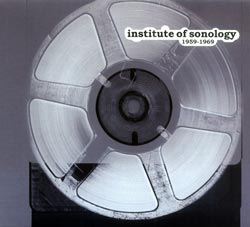
According to the liner notes for this superb collection of Dutch electroacoustic music, The Institute of Sonology was founded in 1960 at the behest of "several people representing cultural institutions who had already taken initiatives in the field of electroacoustic music since 1954." France had the INA-GRM studios and IRCAM; the Institute was essentially its Dutch equivalent, where academics exploited all means of the technology of the time, where some of the region's most progessive and elusive musique concrete (and musique actuelle) sprang up to shock the bourgeoisie.
Dick Raaijmakers remains one of the better-known experimentalists of his era, and his piece here, "Piano-Forte", demonstrates why. Taking a Cageian approach to the piano, Raaijmakers proceeds to literally rip, spindle and mutilate its inner workings, flailing about the instrument's cabinet in a streaming near-cataclysmic evisceration of hoary classical motifs. Frits Weiland's "Studie in Lagen Impulsen" heads down decidedly electric avenues, four minutes of drone before drone music existed, augmented by rattling teapots, shifting extraterrestrial dynamics and strange, aberrant pulsations. On "Reflexen", Ton Bruynel illustrates his unique ability to mimic the likes of Pierre Schaefer and Luc Ferrari, toiling away at four minutes of bizarre percolations and truncated found sounds, elements of which court recognition before they're instantly dashed into sonic oblivion.
The three remaining works on hand take longer to reveal their peculiar irregularities and weirdly assertive characteristics, spread out over epic durations. Konrad Boehmer's "Aspekt", recorded between 1966 and 1968, predates the notion of Eno's "studio as instrument" by a full decade, running tapes backwards, spinning bizarre loops about like a carousel morphing into a cyclotron, blending fierce noises into what becomes an almost bacchanalian feast for the senses. "Funktion Orange" finds the well-known provocateur Gottfried Michael Koenig taking over seventeen minutes to erect towering, robotic edifices of sound, only to jettison them out amongst the detritus of space; his piece is so ebullient with the joys of early 60s machinery it recalls the similar explorations of Delia Derbyshire and her BBC Radiophonic colleagues. Rainer Riehn's closing quarter-hour-plus "Chants de Maldoror" predates the kind of minimal silent aural movies made legion years later by the likes of Bernhard GŁnter and Steve Roden, using great chunks of invisibility and soundlessness in between curdling tonal clusters and mutant brass. Pushing 40 years old, these provocative works haven't lost one iota of their ability to confuse, titillate, and awe.
Comments and Feedback:



More Recent Reviews, Articles, and Interviews @ The Squid's Ear...


|

